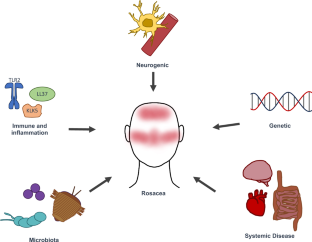Drugs & Aging ( IF 2.8 ) Pub Date : 2024-04-23 , DOI: 10.1007/s40266-024-01115-y Jennifer J. Lee , Anna L. Chien

|
Rosacea is a chronic inflammatory skin condition that is often more severe in older patients. The main clinical features are erythema, telangiectasia, and inflammatory lesions of the face. The pathogenesis of this condition is not fully understood but certainly multifaceted. Immune and inflammatory dysregulation, genetics, neurogenic dysregulation, microbiome dysbiosis, and systemic disease have all been implicated in rosacea pathogenesis. As we better understand the various pathways that lead to rosacea, we acknowledge that the different symptoms may have unique underlying triggers and mechanisms. Aging also impacts rosacea diagnosis and treatment. Older adults have more severe rosacea symptoms while also having more sensitive and fragile skin than younger patients; therefore, rosacea treatments for older patients require a balance between delivering adequate potency while also minimizing skin irritation and other adverse effects. Until recently, rosacea diagnoses were based on concrete subtypes that did not necessarily capture each patient’s manifestation of rosacea. There is now an emphasis on more personalized phenotype-based diagnoses and treatments, which allows for more emphasis on treating individual symptoms and accounting for the unique characteristics of older patients. Centrofacial erythema is best treated with brimonidine and oxymetazoline, while phymatous change and telangiectasia are best treated with surgery and laser ablation. Treatment for rosacea papules and pustules ranges from topicals, such as azelaic acid, ivermectin, metronidazole, minocycline, and encapsulated benzoyl peroxide, to systemics, such as doxycycline and isotretinoin. It is important to understand these treatments in relation to adverse effects and drug interactions that may specifically arise in older populations to provide optimal care. As we advance in understanding rosacea's pathogenesis and adopt personalized phenotype-based approaches, optimizing care for older patients becomes crucial. Continued research into novel treatments is essential to address their unique needs.
中文翻译:

老年人的红斑痤疮和药物治疗
红斑痤疮是一种慢性炎症性皮肤病,在老年患者中通常更为严重。主要临床特征为面部红斑、毛细血管扩张和炎性病变。这种情况的发病机制尚不完全清楚,但肯定是多方面的。免疫和炎症失调、遗传学、神经源性失调、微生物群失调和全身性疾病都与红斑痤疮的发病机制有关。随着我们更好地了解导致红斑痤疮的各种途径,我们认识到不同的症状可能具有独特的潜在触发因素和机制。衰老也会影响红斑痤疮的诊断和治疗。与年轻患者相比,老年人的红斑痤疮症状更严重,同时皮肤也更敏感和脆弱;因此,老年患者的红斑痤疮治疗需要在提供足够效力的同时尽量减少皮肤刺激和其他不良反应之间取得平衡。直到最近,红斑痤疮的诊断都是基于具体的亚型,这些亚型不一定能反映每位患者的红斑痤疮表现。现在强调更加个性化的基于表型的诊断和治疗,这使得可以更加重视治疗个体症状并考虑老年患者的独特特征。面部中央红斑最好用溴莫尼定和羟甲唑啉治疗,而赘肉性改变和毛细血管扩张最好用手术和激光消融治疗。酒渣鼻丘疹和脓疱的治疗范围从局部用药(如壬二酸、伊维菌素、甲硝唑、米诺环素和胶囊过氧化苯甲酰)到全身用药(如强力霉素和异维A酸)。重要的是要了解这些治疗与老年人群中可能特别出现的不良反应和药物相互作用的关系,以提供最佳护理。随着我们对红斑痤疮发病机制的了解不断深入,并采用基于表型的个性化方法,优化老年患者的护理变得至关重要。继续研究新疗法对于满足他们的独特需求至关重要。



























 京公网安备 11010802027423号
京公网安备 11010802027423号